As you probably know by now, I collect books the way a magnet collects iron filings. Whatever you want to do with your writing life—or with your life in general—there’s a book for that! And probably a class as well. Do an online search for writing classes in your area and see what comes up! Some have a modest fee—or an immodest one! Check local libraries and retirement communities, which in the Richmond area often offer such instruction free.
Just now, writing memoir is popular, especially among older people. One of the points stressed in the recent James River Writers Conference panel on Compelling Characters was that even villains are heroes in their own stories. People want their hero stories known. So there are lots of classes on memoir writing, and books as well. These include Natalie Goldberg’s Old Friend from Far Away; Sue William Silverman’s Fearless Confessions; Lisa Dale Norton’s Shimmering Images; Frank P. Thomas’s How to Write the Story of Your Life; and Judith Barrington’s Writing the Memoir.
Every writer’s heard the advice, “Write what you know.” And what do you know better than your own life, right? But memoir is supposed to be as thorough, true, and factual as the writer can make it. So memoir isn’t for everyone. And so far at least, it’s not for me. Of the dozens of short stories I’ve had published, none is memoir.
On the other hand, most of them are memoir-based fiction. Such fiction still tells a true story, but is based only partly on “what really happened.” There are fewer helpful books in this area—on my shelves, at least—but two recent favorites are by Meg Files and Robin Hemley.
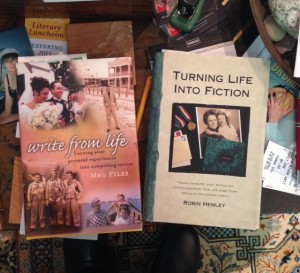
I’m working on a collection now titled Almost Family. As you might gather from that title, I include other people’s lives in my writing, too. One of my earliest publications was “The Pig Sticker.” The factual part of that story is my father and uncle butchering hogs. The true but fictional parts are everything else. In actuality, I was the toddler throwing my rag doll into the horse watering trough. In story as written, I was older, helping my mother and aunt with butchering-day chores and overhearing conversation that never happened. You can read that story here on my website. In Different Drummer, several of the stories are memoir-based, including “After The Fair,” which draws on three different women’s lives for the factual parts.
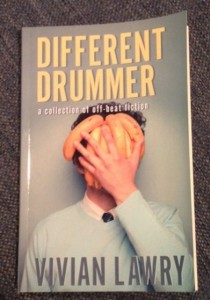
It’s perfectly legitimate to use bits of your real life or the lives of those you know in your writing. This is true whether you are writing memoir, essay, fiction, or poetry. As Susann Cokal told the audience at a past JRWC, “People will always look for you in your writing. If you write a mad, passionate sex scene that takes place on top of a desk, people visiting your office or study will look askance at your desk—and may even ask whether that’s the one.” To spare me—and my family—I like being able to say, “But it’s fiction!”
Saturday and Sunday were two great, packed, informative days! By the end of the Library of Virginia’s Annual Literary Luncheon, I was too caught up in events to write much, but that dam is about to break.
I’ve attended JRW Conferences since the earliest days, back when they were held at the Library of Virginia. I really liked that venue, the ambience, the close, personal feel of it. But the annual meeting outgrew the Library’s space. This year we met at the Greater Richmond Convention Center. It feels much more sterile, but there is plenty of room for meetings, plenary sessions, book signings and sales, plus convenient parking. Plenty of room for growth!
Let me say up front that the absolutely worst thing about JRWC is that I couldn’t attend every session. For example, on Saturday the concurrent sessions offered from 3:30-4:30 were How to Locate, Lure, and Land the Right Agent; To MFA or Not to MFA (virtues and vices of the academic route); Writing Diversity into Your Fiction (representing the larger world in your fiction, how and why); and 50 Shades of Red (on various aspects of writing erotica). What writer wouldn’t want to know all of that? (Well, maybe the kids/YA writers could skip the erotica.)
On the other hand, last week I mentioned that JRW classifies sessions by track. This year’s tracks were Diversity in Writing, Writing for Kids/YA, Poetry, The Pillars of Story, and Writing as Career 2.0. I tended toward The Pillars of Story, but not exclusively. Freedom to jump the tracks is one of the delights of the conference.
Hoping to find an agent for Nettie’s Books soon, I attended the session on getting the right agent (David Henry Sterry, Arielle Eckstut, Heather Flaherty, and Helen Heller, Bill Blume moderating). Although there was a lot of diversity on many things, (e.g., appropriate level of formality/informality) two areas of unanimity stand out: (1) research agents you intend to query; and (2) follow their online submission guidelines to the letter! The diversity of personalities on the panel was evidence that you (the writer) really should try to get a handle on your prospective agent as a person. Places to look are Facebook, blogs, Twitter, and any books the agent might have written. It also helps to hear them speak at a conference such as JRW, or meet them in a one-on-one session.
I’m currently working on a new novel, and the first 30 pages or so are pretty ho-hum. The presentation on conflict and tension was excellent (Raising the Stakes with Leah Ferguson, Valley Haggard, and Amy Sue Nathan, moderated by Jon Sealy). They reminded me of multiple aspects of tension and conflict: stakes can be personal or universal; conflict can be internal or external; a blocked goal = conflict; focus on physical or emotional danger; in every case, imagine the worst possible thing that could realistically happen in this situation and write it—you can always dial it back later for nuance. One thing I found especially helpful was Valley Haggard’s comment that readers connect with shame, pain, vulnerability, failure, and flaws. I wish I had a picture!
A Fine Romance (Leah Ferguson, Mary Chris Escobar, Amy Sue Nathan, moderated by M.M.Finck) brought genre into focus—women’s fiction vs. romance, into particular—and endings (happily ever after, happily for now, together but bittersweet because one or both had to sacrifice for it). Beyond that, what struck me is that their advice for writing a good romance or book of women’s fiction sounded just like the advice for good writing in general! Which reminds me: at the Festival of the Written Word, I’m on a panel with a title something like When Romance Meets Mystery. We shall see. Again, I wish I had a photo, but I was too far back in the hall.
But I did get a picture of the panel for Writing Memorable Characters: Stacy Hawkins Adams, Bruce Holsinger, Amy Sue Nathan, Kristina Wright, moderated by Josh Cane.
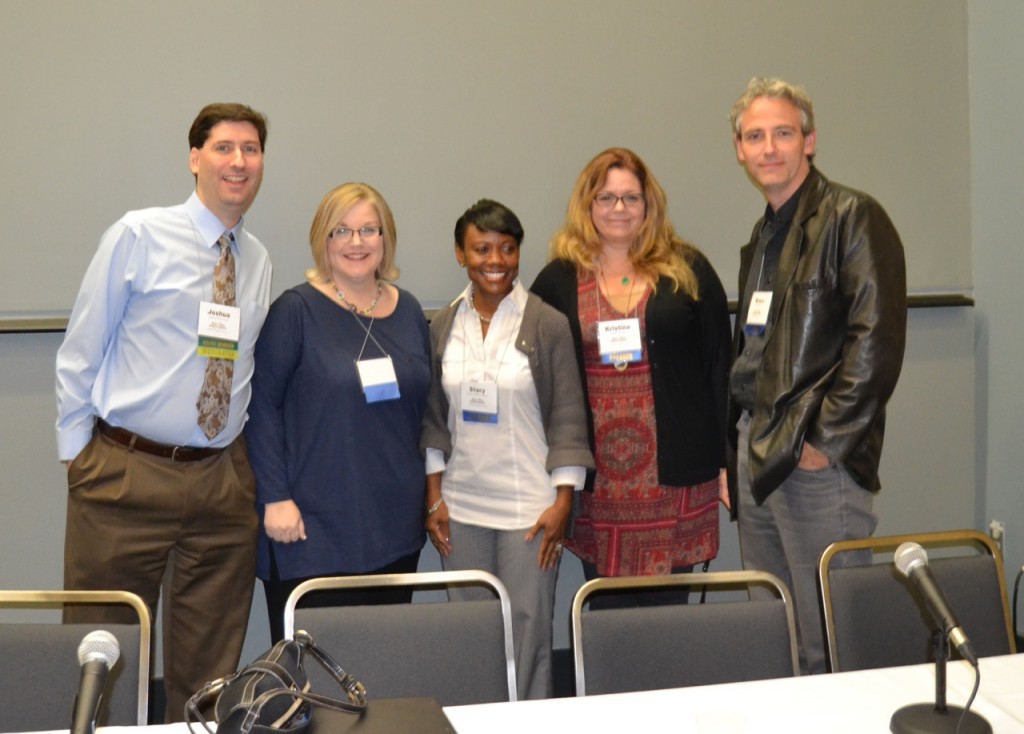
The variety of writing represented—inspirational women’s fiction and non-fiction, historical fiction, women’s fiction and romance, erotica—underscored the over-all rule that every type of writing (including memoir) needs memorable characters, and characters the reader cares about. The heroes and heroines need flaws. The bad characters need a good side. And one effective way of establishing both is to give readers the backstory.
The last plenary session was the Pitchapalooza (David Henry Sterry, Arielle Eckstut, and Rebecca Podos) during which the names of volunteers were drawn from a plastic pumpkin and each had 1 minute—precisely one minute!—to pitch his/her book. Great fun, and very informative as the panel commented on the stronger and weaker aspects of each pitch.
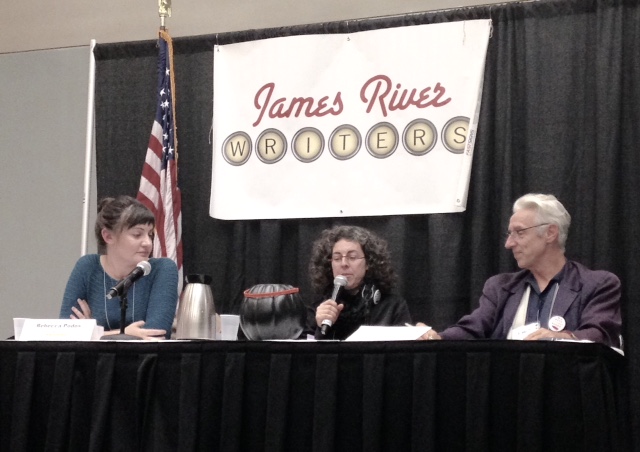
The closing was brief, but celebrated the winners of the Best Unpublished Novel Contest, the Emyl Jenkins Award, and Pitchapalooza. Although not a winner, I was recognized as a finalist in the Best Unpublished Novel Contest. Very gratifying. But egocentric being that I am, I wish the awards (except Pitchapalooza, of course) had been announced a the beginning of the conference. Maybe people I didn’t know before would have congratulated me!
Alas, the conference wasn’t all about me. It was mostly about the books—and there were many to be had, and signed. Fountain Bookstore sold the books of all the presenters.
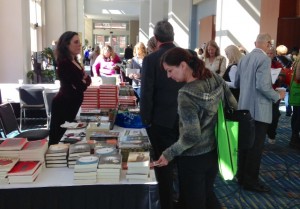
I usually come away from the JRWC feeling that I got more than I paid for. Unfortunately, this year, that included a raging cold, including coughing and congestion, that laid me low as of Monday morning. I assume it was all the back-slapping, handshaking, and hugging.
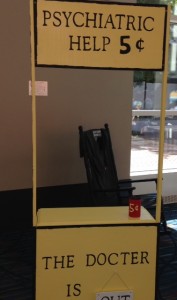
On the other hand, a nasty cold was a great reason to put my feet up, review my notes, and enjoy the contents of my conference bag. I checked the writing classes offered by VMFA Studio School and the Visual Arts Center; considered invitations to submit to the next Poetry Virginia Annual contest and join the Virginia Writers Club; and I could browse the free issues of Richmond Magazine and Broad Street. Already looking forward to next year! Though I did suggest to Katharine Herndon (JRW Executive Director) that next year they try to get a bright colored conference bag!
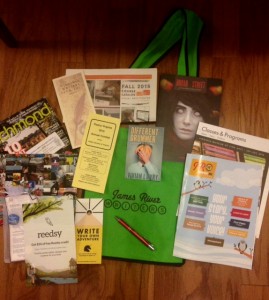
Every writer wants—or should want—to create characters who are vivid, interesting, and memorable. My advice is to choose a quirky interest that will allow you to illuminate various aspects of your character’s character.
Take turtles, for example. You’ll recall from my blog posts on August 15 and August 22, I have an affinity for Eastern box turtles. I enjoy them in situ. When I discovered the male turtle I’d encountered periodically over the past few years in the middle of the cul de sac in front of my house, smooshed by a car, I went into a funk. Two days later, I found a baby turtle—about the size of a fifty-cent coin, so new its shell was still flexible—I felt both joy and concern. I picked it up from the sidewalk and released it on the bank behind my house. The next day, I saw a baby turtle smooshed in a driveway across the street. I cried. Was it “my” turtle or a clutch mate? Should I have moved it from the sidewalk to grass closer to where it might have been trying to go? More recently, I found this male turtle on the bank behind my house— younger, I think, than the one that died. Suddenly, the world looked brighter again.
Consider a fictional character with a turtle interest, then answer a few questions. Is it a house turtle or turtles in the wild? What might either answer reveal about your character? Much can be gleaned from how a person interacts with a pet. We’re more familiar with dogs and cats, maybe birds; how might interacting with a turtle be similar and different? Where did the interest in turtles come from?
Does the turtle hold some symbolic importance for your character? Turtle symbolism includes order, creation, patience, strength, stability, longevity, innocence, endurance, and protection.
Does the turtle interest originate in cultural or ethnic roots? The symbolism of turtles varies widely around the world, so do a little research depending on the ethnic heritage of your character: Africa, Egypt, ancient Mesopotamia, Greece, ancient Rome, Malaysia, China, India, Japan, Vietnam, Taiwan, North America, South America, Tahiti, Polynesia.
Or maybe it’s an interest in turtles in specific venues: folklore, literature, children’s books, films and television, even video games. If you want to get really esoteric, make it an interest in turtles on old coins, flags, or heraldry.
Much as I favor turtles, they are not the only rich way to quirk your character. My favorite all-purpose symbolism reference—animals, dates, numbers, plants, etc.—is The Penguin Dictionary of Symbols.
Sometimes a more specialized examination of symbols is appropriate.
I once wrote a short story titled “Speak to Me” in which the main character is a woman who carves grave stones and communicates with her anonymous lover through the symbols of flowers and funerary art. (This story appeared in Apalachee Review, Number 56, 2006, and is reprinted in the Different Drummer collection.)
Get beyond fiddling with hair or popping gum and choose a rich quirk for your character. If it’s a novel, you are going to be spending a lot of time together, and if you aren’t interested, neither will your reader be!
The Principle of Least Interest
Why Women Have Sex: Character Motivation Matters
Rational and Irrational Behavior in Your Characters: Guest Post on Thrill Writers

My short answer is, “Everywhere.” The somewhat longer answer is newspapers (especially news of the weird), magazines, tidbits on TV, conversations (overheard and otherwise), photos, books, life events (mine and others’), obituaries—i.e., everywhere. I tend toward the dark and the odd.
The recent blooming of a corpse flower at the Denver Botanic Gardens reminds me of my story “Bunga Bangkai” in Different Drummer. All of the stories in that collection are weird, but this one is extremely exotic and esoteric. It started when I came across a news story about a corpse flower blooming in the University of Connecticut greenhouses at about the same time that I somewhere heard or read the phrase “garden of heads.” The result was magical realism, with touches of animism and number symbolism—a story of the search for lost love and reconnection. Here are the opening paragraphs:
I came to The Huntington Botanical Garden to assist at the blooming of the Amorphophallus titanium—the huge shapeless penis. The other botanists here call him Johnson, or sometimes Titan arum, but I prefer to call him Bunga Bangkai, his name in our native Sumatra. Bunga Bangkai is wondrous. In bloom, the spadix—the penis—is fleshy and red, cloaked by a frilly-edged, leafy spathe (or petal) the shape of an upturned fluted bell, pale green on the outside and burgundy velvet on the inside. He resembles his distant cousins the Calla lily, skunk cabbage, and jack-in-the-pulpit, except that the bloom of Bunga Bangkai is three feet across and six feet tall—nearly eight feet if his potato-like corm is included in the measure. This Bunga Bangkai’s corm–his tuber—looks like a water chestnut and is the size of a small curled-up child.
For this blooming, I have tended Bunga Bangkai since his bud tip first pierced the earth, nearly three weeks ago. He has grown six inches a day and his bloom-time is near. Two weeks ago, we carried him from the conservatory to the garden, to share this rare spectacle with the people. More than four thousand come each day. At home in Sumatra, he would bloom every year. But here, it will be at least three years before he blooms again. Since his immigration in 1935, fewer than a dozen bloomings have graced the United States.
Funny, but reading that story now, I realize that there are ever more corpse flowers blooming in the U.S. and abroad—which I find very gratifying!
View amazing photos of the corpse flower on Denver Botanic Gardens Facebook Page. Visit the Denver Botanic Gardens website and view the flower on the stinky cam.
Read more from Different Drummer or purchase for the Nook or Kindle.
En route from Hot Springs to Nimrod, I paused at Warm Springs. What were once known as the Warm Springs Baths are now called the Jefferson Pools because Thomas Jefferson so often took the waters here. This is the men’s bathing house, built in 1761.
In 1836, a separate Ladies Pool House was opened, fed by a separate spring. The roof of the octagonal Ladies Pool House is open to the sky. The water is always 98 degrees. Bathing suits are optional. I love it! Both NETTIE’S BOOKS and “War and Murder at Nimrod Hall” have scenes set at the Jefferson Pools.
I was back at Nimrod before the Week 2 writers arrived.
I reset my workspace and polished my memoir a bit. But I also had time for the sort of nature Nimrod is known for.
Week 2 is a more intimate group, 7 total. I had the foresight to ask permission to talk about them on-line, and so will be introducing you to individuals this week.
This week, everyone knows each other to some degree, so we skipped introductions and went directly to “brag time” talk about the year’s accomplishments. Since last Nimrod, I’ve had 5 short stories published, plus the DIFFERENT DRUMMER collection–very gratifying!
We talked about goals for the week. Cathy Hankla (this week’s writer-in-residence) read from her forthcoming book. Charlotte Morgan (who administers the writing workshops ms is writer-in-residence for Week 3) read from the novel she is writing. More about both of them later, but you might want to check them out online.
Returning to Square House under the Nimrod moon, I smiled. The words “incest” and “orgasm” have already been uttered. The topics of “gender-fluid” identity and hashtags have been broached, along with art in place and environmental conservation. It’s going to be that kind of week! 😊
Nimrod Hall, established in 1783, has been providing summer respite from everyday stress since 1906. It has been operating as an artist and writer colony for over 25 years. The Nimrod Hall Summer Arts Program is a non-competitive, inspirational environment for artists to create without the distractions of everyday life. The 2015 Writers’ Workshop writers-in-residence are Sheri Reynolds, Cathryn Hankla, and Charlotte G. Morgan.

 A while back on Facebook, I mentioned that on the recommendation of my ten-year-old granddaughter, I was reading The Cabinet of Curiosities. I made a connection to Different Drummer stories, except for children. Then she read all three volumes of The Hunger Games—which, frankly, seem a bit horrific to me, not to mention advanced. Upon finishing, her comment was, “That was sad.” No nightmares or anxieties or other negative effects are apparent. Maybe her reaction is testimony to the fascination children have always had for (fictional) horror, as evidenced by the longevity of fairytales in their original (as opposed to Disney) versions.
A while back on Facebook, I mentioned that on the recommendation of my ten-year-old granddaughter, I was reading The Cabinet of Curiosities. I made a connection to Different Drummer stories, except for children. Then she read all three volumes of The Hunger Games—which, frankly, seem a bit horrific to me, not to mention advanced. Upon finishing, her comment was, “That was sad.” No nightmares or anxieties or other negative effects are apparent. Maybe her reaction is testimony to the fascination children have always had for (fictional) horror, as evidenced by the longevity of fairytales in their original (as opposed to Disney) versions.
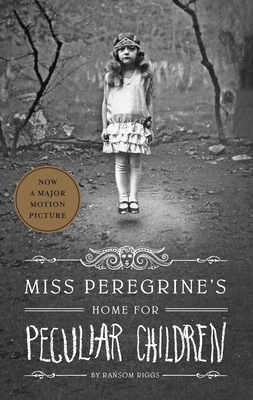 Now she is reading Miss Peregrine’s Home For Peculiar Children. Now, as general background, I would say that my granddaughter is very smart, and a very advanced reader, and her parents are both very intelligent and somewhat unconventional. But she’s ten-and-a-half. And I wonder how the world is changing. As I recall, at about that age, I was reading the Ruth Fielding adventure series. I find this book a real page-turner, but it includes sentences like, “‘Do I look like I blow truckers for food stamps?’ Ricky was a connoisseur of your-mom jokes, but this was apparently more than he could take.” And it includes issues of mental illness (paranoia, etc.)
Now she is reading Miss Peregrine’s Home For Peculiar Children. Now, as general background, I would say that my granddaughter is very smart, and a very advanced reader, and her parents are both very intelligent and somewhat unconventional. But she’s ten-and-a-half. And I wonder how the world is changing. As I recall, at about that age, I was reading the Ruth Fielding adventure series. I find this book a real page-turner, but it includes sentences like, “‘Do I look like I blow truckers for food stamps?’ Ricky was a connoisseur of your-mom jokes, but this was apparently more than he could take.” And it includes issues of mental illness (paranoia, etc.)
 My take-away is that children and families are different, and that what is acceptable reading material varies widely. And most importantly, adults with children or grandchildren who read need to dip into their reading worlds. And be prepared to set limits, encourage, and discuss as needed.
My take-away is that children and families are different, and that what is acceptable reading material varies widely. And most importantly, adults with children or grandchildren who read need to dip into their reading worlds. And be prepared to set limits, encourage, and discuss as needed.
What are your thoughts and experiences?